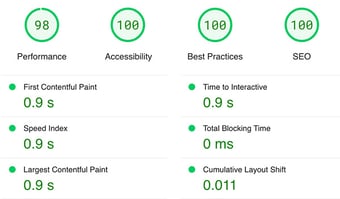HubSpot Smart Content: The Secret to Speed Up Your Site
HubSpot’s Smart Content is a handy feature for customizing your website visitor’s experience. You can set up rules to display different content for...
Take full advantage of the new and improved HubSpot CMS experience with the CLEAN theme.
Have a question and looking for an answer? I've likely got a video for that or an article that covers it.
Google PageSpeed Insights is the gold standard in analyzing the speed and performance of a website. Here is how CLEAN Pro ranks. Not too shabby for a media-rich page.

Report generated: Tues, March 7, 2023, based on Home Page - Opt 1.

Oh, content: the crown jewel of inbound marketing. The idea is simple. Write a bunch of stuff, slap it up on your website, and watch sales start streaming in. But it’s not that easy, is it? You know that. That’s why you’re here.
If you’re struggling to write pieces that sell, you’re not alone. You’re about to learn some tricks that’ll make your competitors wish you’d never stumbled upon this blog post. We’ll cover:
Get your keyboard ready.

Simply put, copywriting is selling with words.
To write good copy then, you need to know how to sell. That means knowing 1) what you sell and 2) why people buy.
Let’s start with what you sell. All writing on your website should sell something. That doesn’t mean it should be “salesy” (please, please, please DON’T be salesy), but it should inspire people to take action.
The action you choose depends on your business strategy. Do you want people to opt-in to your emails? To get to know your brand? To buy your product or service?
Pick a goal, and let’s jump to item two on the sales checklist.
One reason people buy is to move away from pain and toward pleasure. You may have seen (or used) the traditional sales strategy to ask about “pain points” or “what keeps you up at night?”.
Yes, sometimes people know they have a problem and seek a solution, which is when inbound marketing is most potent because content can answer questions and solve problems.
But people don’t always realize they have a pain point. And when they do, they may not feel the problem is urgent enough to make a change.
Change is hard. So hard that humans would often rather put up with a crappy solution instead of rocking the boat.
It’s like ending up hangry at a restaurant with bad service but choosing to stay because “well, we’re already here…”.
We have to dig deeper than the pain/pleasure factor and look at the subconscious mind to see what motivates buyers.
Martin Lindstrom explores the science behind this in his book, Buyology: The Truth and Lies About Why We Buy. He ran a series of neuromarketing studies and found some fascinating results:
Think of a peacock, for example. His beautiful plumage helps him survive and find a mate. Humans aren’t much different. We don’t have tail feathers, but we do have tail lights. Why do you think men love fancy sports cars?
The point? Your reader wants to look and feel good. How can you help them?
Humans love routine (why we’re drawn to rituals and religion). Did you know that Corona invented the idea of drinking beer with a slice of lime? Once the beverage was attached to that ritual, sales boomed.
Do you have a product that should be used at a specific time of day, month, or year? Or paired with another product or service? What ideas or habits would you link it to?
Google recently soft-launched its April Fool’s joke Google Nose. But were they far from something that could have actual market value? According to Lindstrom’s neuromarketing studies, scent and sound create stronger ties than brand logos.
How can you conjure these up for your readers? Sprinkle phonetic and fragrant words into your writing like powdered sugar over freshly baked donuts. Mmmmm.
Mirror neurons make us want to imitate other people’s behavior. If we see another person buying a product, we’re more likely to buy it ourselves.
Why do you think social proof works so well?
The book is an eye-opening read. Lindstrom hopes marketers will use it to better help people find products that will enhance their lives.
Of course, there’s a whole industry built around sales and a gazillion books and articles on the science of selling, so this list of reasons people buy isn’t even close to exhaustive. There’s always more to learn.
You’ve outlined your goal and know why someone would buy. How do you call for action? Here are some tips to make your ask clear and compelling.
“Dearest customer, will you come to your online shopping cart? We’ll to the checkout, thither.”
Even Shakespeare wouldn’t talk like that if he were around today (not that you were trying to write that way, but you get the point).

Use contractions and be casual. Which sounds more natural?
“I would love to see you there.” Or, “I’d love to see you there.”
Pro-tip: proofread your stuff out loud. Does it sound like something you’d say?
Write at least 25 headlines for every piece of content. Then step away and come back to them later to see which stands out to you. You can also use tools like EMV Headline Analyzer to see how your words resonate emotionally.
Don’t try to be too tricky or clever. A business name like “Your Family Dentist” may be boring, but it clearly states what it does. They could have chosen a name like “Gleaming Gums”, or “Intact Teeth For All” but…what does that even mean? Dentures? Orthodontic surgery? Unclear.
You don’t want your readers confused, but you do want them curious. The job of your headline is to get people to read the first sentence. And your opening sentence should get people to read the second sentence. And so forth and so on.
While we’re talking about copy here, we can still learn from some of the world’s great novelists. For example, take the first line of George Orwell’s 1984:
“It was a bright day in April, and the clocks were striking thirteen.”
Kinda makes you go, huh? Why thirteen? Most clocks I know only go up to twelve…
And so you keep reading to try and figure it out.
Use bolds, underlines, italics, and different header tags to draw your reader’s eye. Added bonus: this can help your SEO, too. Read how.
Keep it short.
Keep it punchy.
Use longer phrases to keep it interesting.
On the other hand, if you write like this, your readers may start yawning and realize that they have a meeting in a couple of minutes, and if they see one more run-on sentence, they'll grab their laptop and run for the hills.
Phew.
Simple sells. It’s unnecessary to be extravagant with liberal use of eloquence.
The active voice, to be precise. Like:
“the boy walked the dog”
instead of
“the dog was walked by the boy”.
Also, put your verbs first. For instance:
“Join our newsletter to get tips!”
instead of
“To get tips, join our newsletter!”
Use “you” or “we” and avoid using “I” when possible. Let your reader put themselves in your writing.
Let people know what they can expect to take away. For example, you knew once you saw this post’s headline that you’d get tips to improve your content.
The devil’s in the details, as the saying goes. Instead of a headline like
“healthy cat food ideas”
try
“7 meals to keep your cat healthy all week”.
Hmm, sounds like something my gluttonous cat could use.

Sometimes it helps to sit down and vomit something onto a page, even if it sucks. Tools like 750words.com are great for this. Julia Cameron’s Morning Pages are supposed to be good, too (although truth be told, I haven’t tried her method).
When it comes to editing, that is. Yes, start by spewing words onto the page, but then cut and trim like you’re Santa prepping for a summer trip to The Bahamas.
Grammarly is one of my fav editing tools. But don’t get too caught up with grammar rules, especially if you’re trying to sound informal.
Like “maybe”, “just”, and “possibly”.
Which sounds stronger?
“I just thought maybe we could help you grow your business.”
vs.
“We can help you grow your business.”
I’d argue the latter.
Adverbs extraneously add fluff to your writing. They unnecessarily describe adjectives and nouns and can definitely be removed.
Or
Adverbs add fluff to your writing. They describe adjectives and nouns and can be removed.
The second version is more concise.
Nerd confession: I’ll never forget the major word classes (nouns, verbs, adjectives, and adverbs) thanks to one of my favorite games: MadLibs. If you’re into it, they provide endless fun.
In my humble opinion, practice doesn’t make perfect. Practice makes permanent. What you do consistently builds the groundwork for everything going forward.
So, practice. Practice writing garbage. Practice writing anything at all. Do it every day, try some of the tips above, and before you know it, your content will be hotter than Texas chili. Deeelicious.

And hey, did you try any of these tips? Get any results? Link your new and improved content in the comments below (and we may even send you a virtual high five). :)
.jpg)
HubSpot’s Smart Content is a handy feature for customizing your website visitor’s experience. You can set up rules to display different content for...

If a website launches and no one on the internet sees it, can it still generate business?

So you finally got control over your website and can edit your pages without relying on a dev team. Congrats! You've made it to the next level. But...